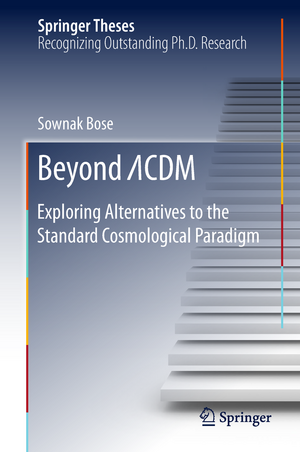Beyond ΛCDM: Exploring Alternatives to the Standard Cosmological Paradigm: Springer Theses
Autor Sownak Boseen Limba Engleză Hardback – 13 aug 2018
| Toate formatele și edițiile | Preț | Express |
|---|---|---|
| Paperback (1) | 636.45 lei 6-8 săpt. | |
| Springer International Publishing – 25 ian 2019 | 636.45 lei 6-8 săpt. | |
| Hardback (1) | 642.68 lei 6-8 săpt. | |
| Springer International Publishing – 13 aug 2018 | 642.68 lei 6-8 săpt. |
Din seria Springer Theses
- 18%
 Preț: 997.88 lei
Preț: 997.88 lei -
 Preț: 389.88 lei
Preț: 389.88 lei - 15%
 Preț: 646.94 lei
Preț: 646.94 lei - 18%
 Preț: 943.43 lei
Preț: 943.43 lei -
 Preț: 399.29 lei
Preț: 399.29 lei - 18%
 Preț: 944.99 lei
Preț: 944.99 lei - 15%
 Preț: 636.80 lei
Preț: 636.80 lei - 18%
 Preț: 941.05 lei
Preț: 941.05 lei - 15%
 Preț: 643.16 lei
Preț: 643.16 lei - 15%
 Preț: 642.68 lei
Preț: 642.68 lei - 18%
 Preț: 1103.62 lei
Preț: 1103.62 lei - 20%
 Preț: 558.83 lei
Preț: 558.83 lei - 18%
 Preț: 1112.30 lei
Preț: 1112.30 lei - 18%
 Preț: 944.19 lei
Preț: 944.19 lei - 18%
 Preț: 1109.92 lei
Preț: 1109.92 lei - 18%
 Preț: 1217.27 lei
Preț: 1217.27 lei - 15%
 Preț: 640.06 lei
Preț: 640.06 lei - 15%
 Preț: 636.45 lei
Preț: 636.45 lei - 15%
 Preț: 640.06 lei
Preț: 640.06 lei - 15%
 Preț: 640.88 lei
Preț: 640.88 lei -
 Preț: 389.70 lei
Preț: 389.70 lei - 20%
 Preț: 563.91 lei
Preț: 563.91 lei -
 Preț: 393.35 lei
Preț: 393.35 lei - 15%
 Preț: 637.93 lei
Preț: 637.93 lei - 15%
 Preț: 641.85 lei
Preț: 641.85 lei - 18%
 Preț: 1225.94 lei
Preț: 1225.94 lei - 20%
 Preț: 551.36 lei
Preț: 551.36 lei - 18%
 Preț: 1229.10 lei
Preț: 1229.10 lei - 15%
 Preț: 639.25 lei
Preț: 639.25 lei - 18%
 Preț: 999.45 lei
Preț: 999.45 lei - 15%
 Preț: 640.06 lei
Preț: 640.06 lei - 18%
 Preț: 1220.45 lei
Preț: 1220.45 lei - 18%
 Preț: 1116.26 lei
Preț: 1116.26 lei - 18%
 Preț: 1110.72 lei
Preț: 1110.72 lei - 18%
 Preț: 1000.87 lei
Preț: 1000.87 lei - 18%
 Preț: 891.17 lei
Preț: 891.17 lei - 15%
 Preț: 640.06 lei
Preț: 640.06 lei - 5%
 Preț: 1154.07 lei
Preț: 1154.07 lei - 15%
 Preț: 635.96 lei
Preț: 635.96 lei - 15%
 Preț: 640.88 lei
Preț: 640.88 lei -
 Preț: 387.20 lei
Preț: 387.20 lei - 18%
 Preț: 1109.92 lei
Preț: 1109.92 lei -
 Preț: 385.25 lei
Preț: 385.25 lei -
 Preț: 385.25 lei
Preț: 385.25 lei - 18%
 Preț: 1112.30 lei
Preț: 1112.30 lei - 18%
 Preț: 999.45 lei
Preț: 999.45 lei -
 Preț: 386.99 lei
Preț: 386.99 lei - 15%
 Preț: 637.13 lei
Preț: 637.13 lei - 20%
 Preț: 554.21 lei
Preț: 554.21 lei - 20%
 Preț: 555.59 lei
Preț: 555.59 lei
Preț: 642.68 lei
Preț vechi: 756.09 lei
-15% Nou
Puncte Express: 964
Preț estimativ în valută:
122.99€ • 133.55$ • 103.31£
122.99€ • 133.55$ • 103.31£
Carte tipărită la comandă
Livrare economică 22 aprilie-06 mai
Preluare comenzi: 021 569.72.76
Specificații
ISBN-13: 9783319967608
ISBN-10: 3319967606
Pagini: 213
Ilustrații: XXXIV, 181 p. 49 illus., 31 illus. in color.
Dimensiuni: 155 x 235 mm
Greutate: 0.48 kg
Ediția:1st ed. 2018
Editura: Springer International Publishing
Colecția Springer
Seria Springer Theses
Locul publicării:Cham, Switzerland
ISBN-10: 3319967606
Pagini: 213
Ilustrații: XXXIV, 181 p. 49 illus., 31 illus. in color.
Dimensiuni: 155 x 235 mm
Greutate: 0.48 kg
Ediția:1st ed. 2018
Editura: Springer International Publishing
Colecția Springer
Seria Springer Theses
Locul publicării:Cham, Switzerland
Cuprins
Introduction.- Statistical Properties of Warm Dark Matter Haloes.- Substructure and Galaxy Formation in Warm Dark Matter Simulations.- Reionisation in Sterile Neutrino Cosmologies.- Testing the Quasi-Static Approximation in F (R) Gravity Simulations.- Speeding up N-Body Simulations of Modified Gravity: Chameleon Screening Models.- Conclusions and Future Work.
Notă biografică
Originally from Kolkata, India, the author completed his undergraduate Masters degree in Physics from the University of Oxford in 2013. Following this, he obtained a PhD in Astrophysics from Durham University, under the supervision of Prof. Carlos Frenk, Dr. Baojiu Li and Prof. Adrian Jenkins. Currently, he is a ITC Postdoctoral Fellow at the Harvard-Smithsonian Center for Astrophysics in Cambridge, MA (USA).
Textul de pe ultima copertă
This book employs computer simulations of ‘artificial’ Universes to investigate the properties of two popular alternatives to the standard candidates for dark matter (DM) and dark energy (DE). It confronts the predictions of theoretical models with observations using a sophisticated semi-analytic model of galaxy formation. Understanding the nature of dark matter (DM) and dark energy (DE) are two of the most central problems in modern cosmology. While their important role in the evolution of the Universe has been well established—namely, that DM serves as the building blocks of galaxies, and that DE accelerates the expansion of the Universe—their true nature remains elusive. In the first half, the authors consider ‘sterile neutrino’ DM, motivated by recent claims that these particles may have finally been detected. Using sophisticated models of galaxy formation, the authors find that future observations of the high redshift Universe and faint dwarf galaxies in the Local Group can placestrong constraints on the sterile neutrino scenario. In the second half, the authors propose and test novel numerical algorithms for simulating Universes with a ‘modified’ theory of gravity, as an alternative explanation to accelerated expansion. The authors’ techniques improve the efficiency of these simulations by more than a factor of 20 compared to previous methods, inviting the readers into a new era for precision cosmological tests of gravity.
Caracteristici
Nominated as an outstanding PhD thesis by the University of Durham, England Employs state-of-the-art, high-resolution cosmological simulations Confronts the predictions of theoretical models with observations using a sophisticated semi-analytic model of galaxy formation Provides an in-depth study of two of the most central problems in modern cosmology—the nature of dark matter (DM) and dark energy (DE)
